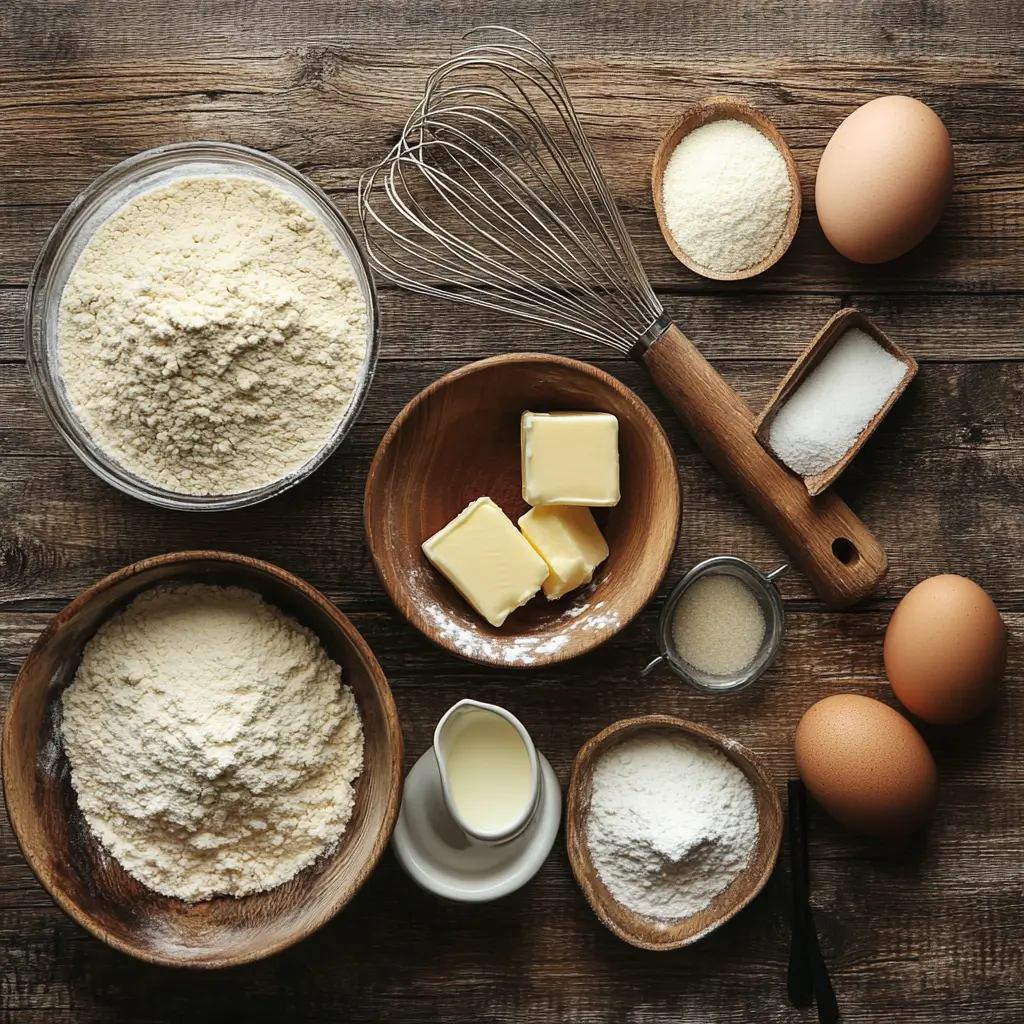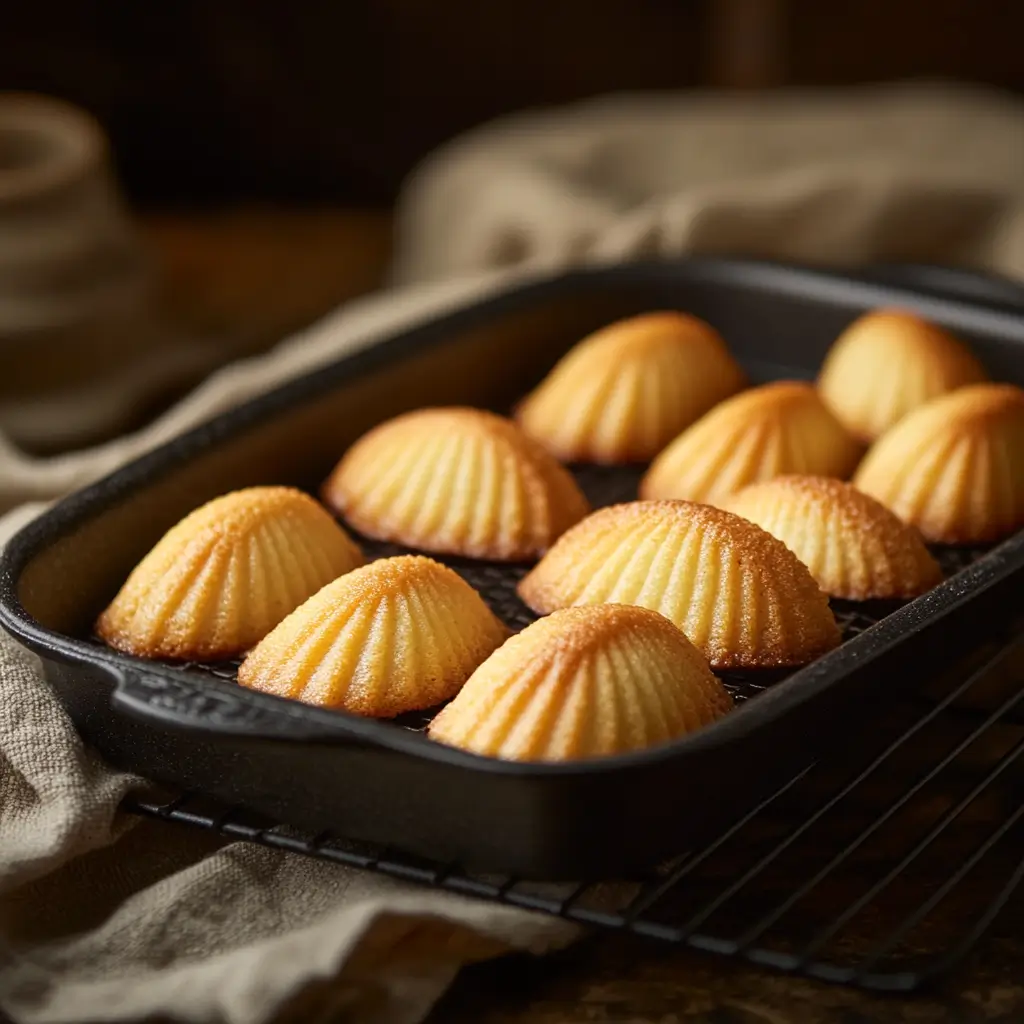Madeleine cookies are a classic French pastry, known for their distinct shell shape and delicate, buttery flavor. While the traditional recipe relies on butter and eggs for texture, using cream elevates the experience, making them softer, richer, and more indulgent.
Whether you’re an experienced baker or a beginner looking to master the art of madeleines, you’ll discover why cream enhances madeleines, how to avoid common baking mistakes, and the secrets to achieving the perfect texture.
By the end of this, you’ll have the ultimate madeleine cookies recipe using cream, along with expert insights that ensure moist, golden, and utterly delicious results every time.
Table of Contents
Why Use Cream in Madeleines?
While traditional madeleine recipes rely on butter and eggs for texture, cream is a game-changer. It enhances softness, richness, and moisture, resulting in a lighter, melt-in-your-mouth experience.
1. Prevents Dryness
Madeleines tend to dry out quickly, but cream locks in moisture, keeping them tender for longer. If you’ve ever had a dry or crumbly madeleine, you’ll appreciate the difference heavy cream makes.
2. Enhances Flavor & Texture
Cream provides a smooth, velvety texture that’s softer than traditional recipes. Additionally, it enhances the buttery, vanilla-infused flavor, making each bite more indulgent.
3. Adds a Subtle Tenderness
The high-fat content in cream coats the flour particles, which helps produce a delicate, airy crumb rather than a dense, cake-like texture.
If you love light, rich, and moist cookies, cream is the secret ingredient you’ve been missing.
Ingredients & Step-by-Step Instructions
This easy-to-follow recipe guarantees perfect results every time. Let’s start with the essential ingredients.

Ingredients List
| Ingredient | Amount | Notes |
|---|---|---|
| Unsalted butter | ½ cup (113g) | Melted and slightly cooled |
| Heavy cream | ¼ cup (60ml) | Adds richness and moisture |
| Eggs | 2 large | Room temperature |
| Granulated sugar | ½ cup (100g) | Helps aerate the batter |
| All-purpose flour | ¾ cup (90g) | Sifted for light texture |
| Baking powder | ½ tsp | Ensures a slight rise |
| Vanilla extract | 1 tsp | Classic flavoring |
| Lemon zest | 1 tsp | Optional, for brightness |
| Powdered sugar | For dusting | Adds a decorative touch |
Step-by-Step Instructions
1. Prepare the Batter
- In a large mixing bowl, whisk together eggs and sugar for 3-4 minutes until pale and fluffy. This process incorporates air, making the madeleines light and soft.
- Slowly pour in melted butter and heavy cream, gently folding to preserve the batter’s airy texture.
- Sift in flour and baking powder, stirring just until combined. Overmixing can lead to dense cookies.
- Finally, add vanilla extract and lemon zest, blending until smooth.
2. Chill the Batter
- Cover the batter and refrigerate for at least 1 hour.
- This step is crucial as it allows the batter to firm up, which creates the classic hump on the madeleines.
3. Prepare the Molds
- Preheat the oven to 375°F (190°C).
- Grease and lightly flour a madeleine pan to prevent sticking.
4. Bake the Madeleines
- Spoon 1 tablespoon of batter into each mold—don’t spread it out.
- Bake for 10-12 minutes, or until golden brown with crisp edges.
- The signature hump should appear after the first few minutes.
5. Cool & Serve
- Allow the madeleines to cool in the pan for 2 minutes before transferring them to a wire rack.
- Dust with powdered sugar and enjoy warm!

Perfecting the Madeleine Texture
Even if you follow the recipe correctly, achieving the ideal madeleine texture requires attention to small details. Here’s how to ensure a light, soft interior with a slight crisp on the edges:
- Proper Batter Consistency: The batter should be smooth yet thick. If it’s too runny, the cookies may spread too much. If it’s too thick, they might turn out dense.
- Egg Whipping Technique: Beating the eggs and sugar until pale and fluffy introduces air into the batter, which helps create a lighter texture.
- Flour Incorporation: Always sift the flour and fold it gently into the batter. Overmixing can develop too much gluten, leading to a chewy rather than delicate madeleine.
By following these techniques, you’ll achieve perfectly soft, buttery, and slightly crisp madeleines every time.
Expert Tips for Perfect Madeleines
1. How to Keep Madeleines Moist?
- Do not overbake: Check at 10 minutes and remove as soon as the tops spring back when touched.
- Use high-fat ingredients: Heavy cream and butter keep the texture soft.
- Store properly: Place them in an airtight container to retain freshness.
2. What Can I Use Instead of a Madeleine Mold?
If you don’t own a madeleine pan, try these alternatives:
- Mini muffin tins: The texture remains similar, but they lose the shell shape.
- Silicone baking molds: Offer easy release and a slightly softer texture.
- Shallow cupcake trays: Work in a pinch but won’t give the signature ridges.
3. Why Are My Madeleines Dry?
- Overmixing: Stir only until the flour is incorporated to avoid toughness.
- Overbaking: Even one extra minute can make them too firm.
- Low-fat substitutes: Using low-fat milk instead of cream can lead to less moisture.
Common Mistakes & How to Avoid Them
Mistake 1: Skipping the Resting Step
- Resting the batter is key to getting the signature hump.
- Without chilling, the batter spreads too quickly, losing its distinctive shape.
Mistake 2: Overfilling the Molds
- Overfilled molds lead to overflow and uneven baking.
- Stick to ¾ full for perfectly shaped cookies.
Mistake 3: Not Greasing the Pan Properly
- Without proper greasing, the delicate edges may stick and break apart.
- Always grease and flour the pan—even if it’s nonstick!
How to Achieve the Signature Madeleine Hump
One of the most recognizable features of a well-made madeleine is its distinct hump. Here’s how to guarantee this effect:
1. The Science Behind the Hump
The hump forms due to the temperature contrast between the chilled batter and the hot oven. This sudden burst of heat forces the center of the madeleine to rise rapidly, creating the characteristic dome shape.
2. Essential Tips to Get the Perfect Rise
- Chill the batter for at least 1 hour (preferably overnight).
- Start baking at a high temperature (425°F / 220°C) for the first 4 minutes, then reduce to 375°F / 190°C.
- Use room temperature eggs and butter, but ensure the batter is cold before baking.
- Fill each mold about ¾ full to allow for proper expansion without overflowing.
Following these steps guarantees a beautiful, bakery-style hump on your madeleines.
Creative Madeleine Variations
While classic vanilla-lemon madeleines are delightful, experimenting with different flavors adds variety and excitement.
1. Chocolate-Dipped Madeleines
- Melt dark, milk, or white chocolate and dip one half of each cooled madeleine.
- Let them set on parchment paper for 10-15 minutes.
- For extra flair, sprinkle with chopped nuts or shredded coconut.
2. Orange-Almond Madeleines
- Swap lemon zest for orange zest and add ½ teaspoon almond extract.
- This version pairs wonderfully with afternoon tea.
3. Cinnamon Sugar Madeleines
- After baking, brush each madeleine with a little melted butter and coat them in a cinnamon-sugar mix.
- This gives them a snickerdoodle-like flavor.
4. Honey-Lavender Madeleines
- Add 1 tablespoon of honey and ½ teaspoon of dried lavender to the batter.
- The result is a delicate, floral-infused madeleine that’s perfect for springtime gatherings.
These simple tweaks transform the classic recipe into a gourmet delight.
How to Store and Freeze Madeleines
Freshly baked madeleines taste best on the day they’re made, but here’s how to keep them fresh:
Short-Term Storage
- Store in an airtight container at room temperature for up to 3 days.
- If they start losing freshness, warm them in a 300°F (150°C) oven for 3-4 minutes.
Freezing Instructions
- Place baked madeleines in a single layer on a baking sheet and freeze for 1 hour.
- Transfer them to a ziplock bag with parchment paper between layers.
- They will stay fresh for up to 3 months.
- To serve, thaw at room temperature or reheat in the oven.
With proper storage, you can enjoy fresh, homemade madeleines anytime.
FAQs
How to Keep Madeleines Moist?
Avoid overbaking, as even a minute too long can dry them out.
Use high-fat ingredients like butter and cream for a rich, soft texture.
Store in an airtight container to prevent moisture loss.
What is a Substitute for Madeleine Molds?
If you don’t have a madeleine pan, consider these alternatives:
Mini muffin tins – They create a similar texture, but lack the shell shape.
Silicone baking cups – These allow for easy release and gentle baking.
Shallow cupcake trays – Work in a pinch, but won’t form the classic ridges.
Why Are My Madeleines So Dry?
Common reasons for dryness include:
Overmixing the batter, which results in a tough, chewy texture.
Overbaking, causing excess moisture loss.
Not using enough butter or cream, leading to a less tender crumb.
Why Are My Madeleines Sticky After Baking?
Stickiness can be caused by:
Humidity – Moist environments can make them feel tacky.
Improper cooling – Let them cool completely on a wire rack before storing.
Powdered sugar absorption – If dusted too soon, sugar can draw in moisture.
Can I Make Madeleines Ahead of Time?
Yes! To prepare in advance:
Refrigerate the batter overnight for a stronger flavor and better rise.
Freeze fully baked madeleines for up to 3 months and reheat before serving.
How Do I Achieve the Perfect Madeleine Hump?
For the perfect rise and hump:
Chill the batter thoroughly before baking.
Start baking at a high temperature for the first few minutes.
Do not overmix the batter, as a light, airy texture allows for a better rise.
Conclusion
By now, you have all the knowledge needed to master the best madeleine cookies recipe using cream. From expert baking techniques to creative flavor variations, this guide ensures consistently perfect results.
Whether you stick with the classic version or experiment with new flavors, madeleines are an elegant yet simple treat that’s perfect for any occasion.
So, grab your ingredients, preheat your oven, and enjoy baking these rich, soft, and utterly delicious madeleines!
Print
The Best Madeleine Cookies Recipe Using Cream – Soft & Moist
- Total Time: 20-22 minutes
- Yield: One dozen madeleines
Description
These classic French Madeleine Cookies get an upgrade with the addition of heavy cream, resulting in a richer, softer, and more indulgent texture. With their signature shell shape and delicate buttery flavor, these madeleines are perfect for tea time, dessert, or as a delightful homemade gift. Follow this step-by-step guide to achieve moist, golden, and utterly delicious madeleines every time!
Ingredients
- Unsalted butter – ½ cup (113g), melted and slightly cooled
- Heavy cream – ¼ cup (60ml), adds richness and moisture
- Eggs – 2 large, room temperature
- Granulated sugar – ½ cup (100g), helps aerate the batter
- All-purpose flour – ¾ cup (90g), sifted for a light texture
- Baking powder – ½ tsp, ensures a slight rise
- Vanilla extract – 1 tsp, classic flavoring
- Lemon zest – 1 tsp, optional, adds a bright citrus note
- Powdered sugar – for dusting, adds a decorative touch
Instructions
1. Prepare the Batter
- In a large mixing bowl, whisk together eggs and sugar for 3-4 minutes until pale and fluffy. This step is crucial for incorporating air, making the madeleines light and soft.
- Slowly pour in the melted butter and heavy cream, gently folding to preserve the batter’s airy texture.
- Sift in the flour and baking powder, stirring just until combined. Avoid overmixing, as it can make the cookies dense.
- Add vanilla extract and lemon zest, blending until smooth.
2. Chill the Batter
- Cover the batter and refrigerate for at least 1 hour.
- This step is essential for developing the classic hump on the madeleines.
3. Prepare the Madeleine Molds
- Preheat the oven to 375°F (190°C).
- Grease and lightly flour a madeleine pan to prevent sticking.
4. Bake the Madeleines
- Spoon 1 tablespoon of batter into each mold. Do not spread it out—let the batter naturally settle.
- Bake for 10-12 minutes, or until the edges are golden brown and crisp.
- The signature hump should appear within the first few minutes of baking.
5. Cool & Serve
- Allow the madeleines to cool in the pan for 2 minutes before transferring them to a wire rack.
- Dust with powdered sugar and serve warm for the best texture and flavor!
Notes
Expert Tips for Perfect Madeleines:
- Chill the batter: Refrigerating the batter helps the madeleines develop their signature hump.
- Don’t overmix: Gently fold in the flour to maintain a light texture.
- Grease the pan properly: Prevents sticking and ensures easy removal.
- Bake at the right temperature: A preheated 375°F (190°C) oven gives them the perfect rise.
- Prep Time: 10 minutes
- Cook Time: 10-12 minutes
- Category: Breakfast
- Cuisine: French
Nutrition
- Calories: ~120
- Fat: 7g
- Carbohydrates: 12g
- Protein: 2g
